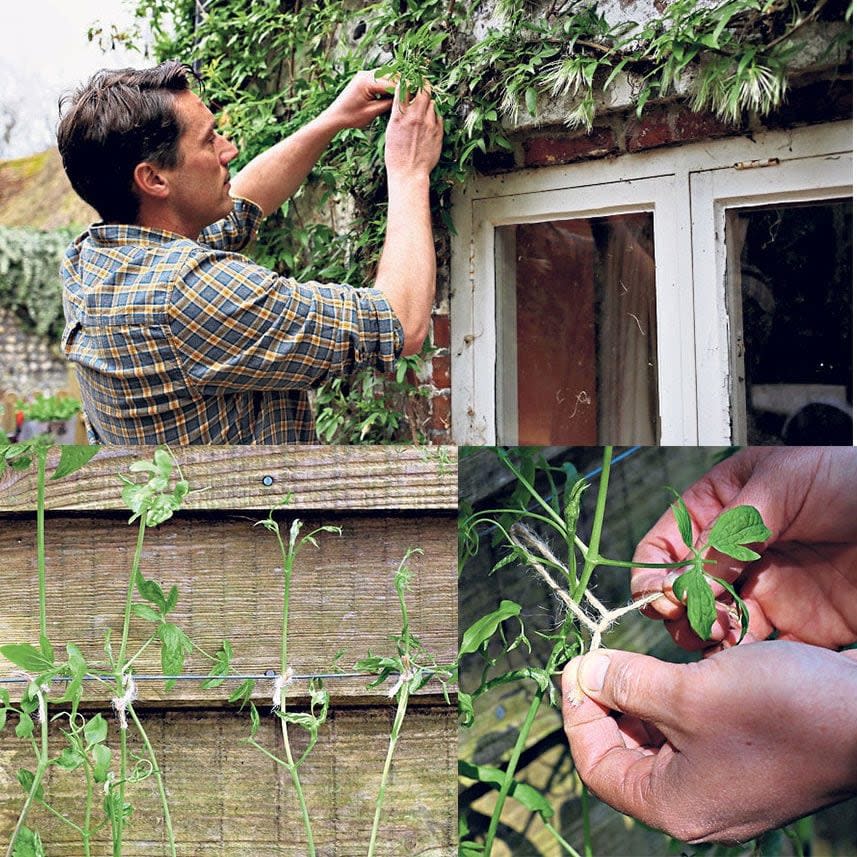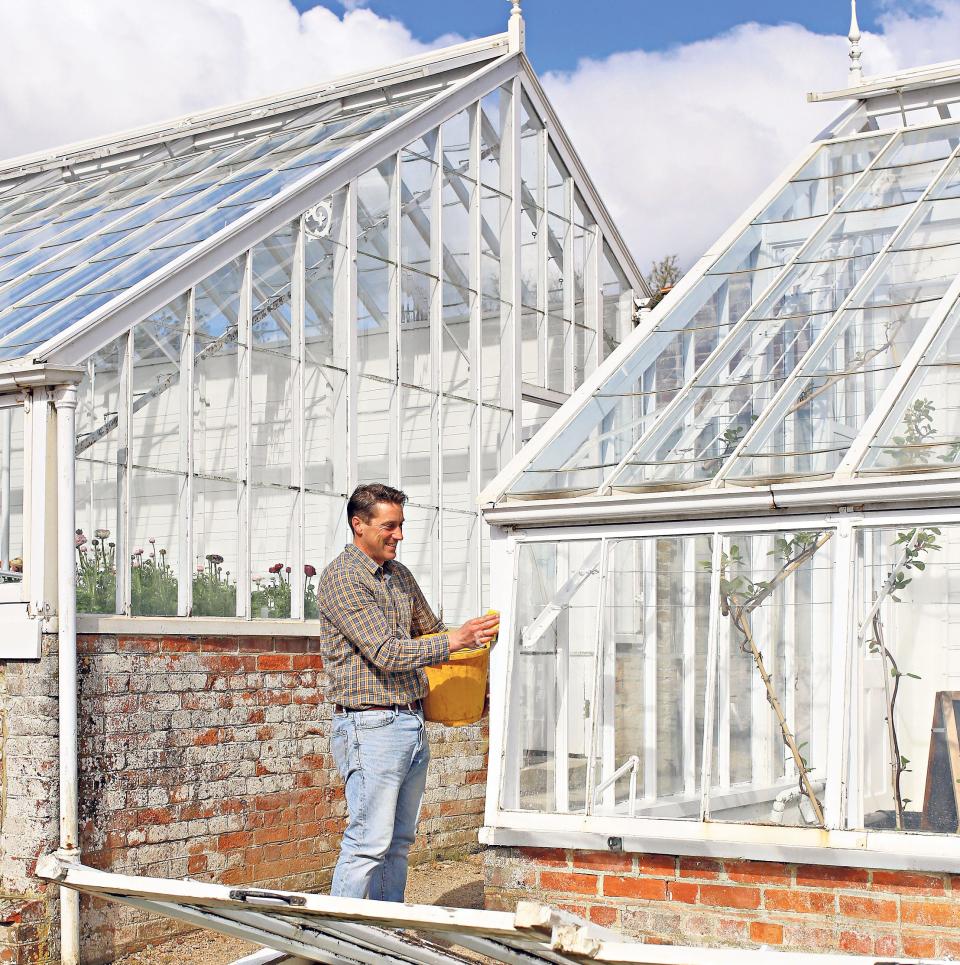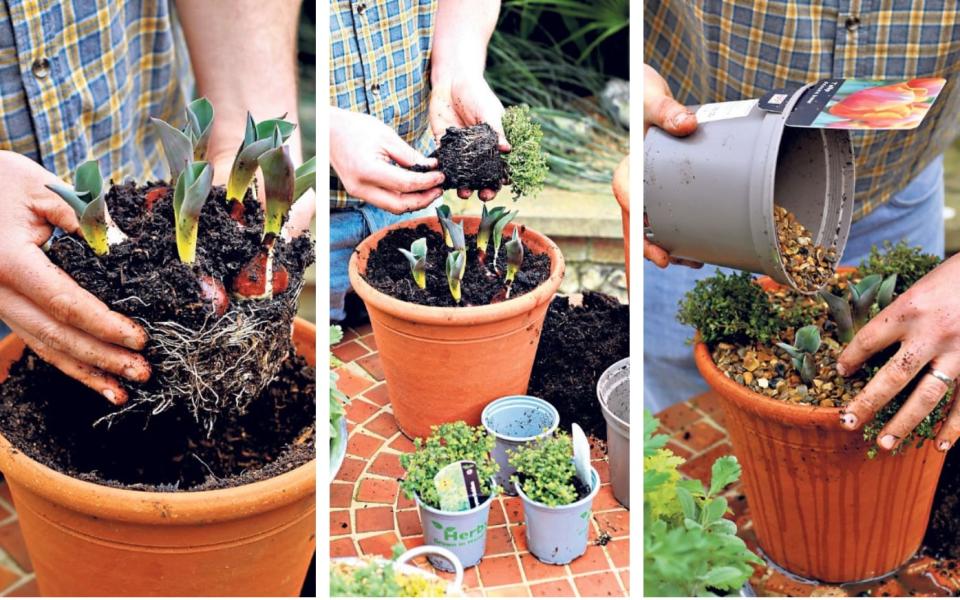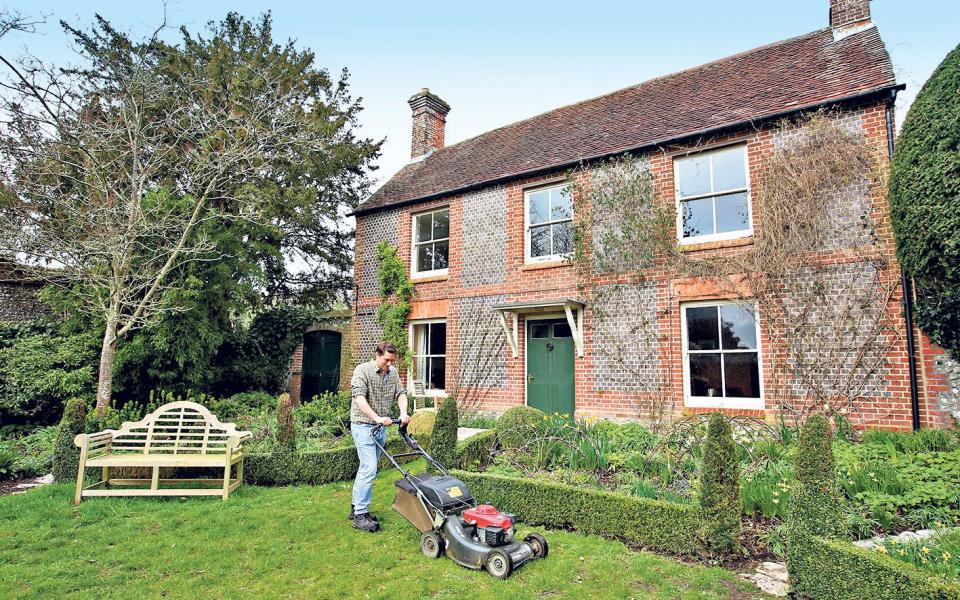10 simple ways to bring your garden back from the dead this weekend

We’ve all noticed a change in the air: birds are singing more audibly, trees are sprouting a green fuzz of growth and the bedroom is full of daylight when the alarm goes off in the morning. With senses and emotions starting to stir, it’s time to get out there and enrich your soul.
April is the most invigorating months in the garden – a great time to roll up your sleeves and get cracking. At West Dean Gardens (where I live and work in West Sussex), I adore the bursting of buds on the fruit trees and the unrivalled feel-good factor of carpets of primroses and daffodils. The orchard is buzzing with life at tree level and below. I can watch bumble bees making their way through swathes of fritillaries, leaving the flowers bouncing as they forage, and I marvel at the way the magnolia flowers sing against a bright blue sky.
This could be the year you grow vegetables, flowers for cutting or dig that wildlife pond you’ve always meant to get around to. So it’s time to get busy: this weekend, reconnect with that green-fingered gardener who’s been hibernating for the last few months and try a few of my top 10 simple ways to bring your garden back to life.
How to revive your garden
1. Trim topiary
Trimming topiary gives a garden an instant facelift and makes the whole space look well-managed and maintained. Most evergreen topiary, such as box and laurel, is now growing quickly and the warmer weather means it is now much less likely to suffer frost damage on young shoots. Before you get these shrubs to the barbers, check that there are no nesting birds – and if you find any, leave well alone until the summer.
If all is clear, target long stems that have rocketed from the desired shape; they will become dominant unless you deal with them, so make sure to prune them back to within the shape or at their origin.

Whether using hedge trimmers, shears or secateurs, go gently with the shaping and remember that you can always take a little more off but you can’t stick any back on. Finally, most standard or lollipop topiary will try to produce leaves along its main stem – these should be removed, too.
2. Pressure wash and weed the patio
If your patio or paving looks a bit tired and you have contemplated replacing it, hold fire for a moment: beneath that layer of algae and grime there’s probably a wonderful set of slabs and stones crying out to be rediscovered. Look online for a local hire company and hire a small pressure washer for the weekend to give paving a facelift.
Go steady when it comes to the cement or mortar between slabs as you don’t want to be loosening or digging that out with the jet of water. Most washers have a nozzle that forms a fan-like spray of water, which you can use like a brush to sweep the grime towards a drain.
The other benefit of pressure washing is that it transforms a slippery surface into a much safer one, which we need as we use paths and patios more regularly during the summer.
3. How to tie in climbers
Never turn your back on climbers such as clematis at this time of year: they grow fast and become unruly very quickly. As new growth emerges, tie shoots into the desired position.
Young shoots can be very brittle, so tying them in regularly is a better approach than wrestling them into submission later. Jute string is perfect for most climbers: I tie it to the support, then loosely tie around the stem, creating a figure of eight, with the centre of the eight between the stem and the support, which acts as a cushion.
You need ties to be tight enough to hold the stem in position but loose enough to allow it to grow and thicken. Check ties regularly and loosen as needed.
Step by step

Step 1
Climbers grow incredibly quickly: you can end up with a wall of spaghetti growing in one direction. Position stems as they grow to ensure all the space is covered. The more regularly you tie them in, the more pleasing the shape will be.
Step 2
Tie string to wires with a simple knot: this acts as a cushion between wire and stem. Then loosely but firmly tie string around young growth and tie off with a double knot. Avoid leaving long tails of string after the knot.
Step 3
Create an equidistant and well-structured framework across the fence or wall to build a strong set of stems, which can then branch and be tied in to fan out. A fan-like network of stems will prevent all the flowering happening at the top.
4. Clean the greenhouse
Greenhouses aren’t as productive in winter as they are during the spring and summer and, as a result, become a Tardis-like facility whereby all sorts of garden paraphernalia is tossed in and forgotten about. This weekend is a great opportunity to reorganise it – clear out that table and chair set, barbecue and paddling pool and create a growing environment to be proud of.
You may find that a layer of algae and dirt has accumulated on the inside and outside of the glass, which will ultimately block light and hinder plant growth. Once you’ve cleared out the space, take a bucket of warm, soapy water, a soft brush and a sponge and get to work.

Gently wash the glass panes and make sure you get into all the crevices. This may seem over the top, but the lighter the greenhouse the better plants will grow. Furthermore, pests overwinter in those hard-to-reach places, so get in there and flush them out – just think of those tasty tomatoes.
5. Grow cut flowers from seed
If you fancy growing cut flowers for the house, April is a perfect time to sow a few cosmos. These eventually grow into the most generous of plants for cutting – you will struggle to keep up with the amount of blooms they can throw at you. There are many different colours and shapes to choose from, so spend an evening browsing websites such as Thompson & Morgan, Sarah Raven and Plants of Distinction for some delightful options. Garden centres also stock a great range of cosmos as young plants if you’d rather get started straight away.
To sow these easy-going beauties, fill a small tray with peat-free compost then firm and water well to settle the level – ideally a centimetre or so below the top of the tray. Cosmos seeds easy to handle, so space them well: you will easily get 20 or so in a small tray. Lightly cover the seeds with more compost and, when seedlings are large enough to handle, prick them out into small pots. Keep in a frost-free place until the end of May, when they can go outside.
6. Clear weeds, feed and mulch
The old saying “One year’s seeds, seven years’ weeds” is very true: if we allow that first flush of annual weeds to grow, flower and produce lots of seeds, we’ll be chasing weeds around our gardens all summer – every year. Weeds are incredibly successful plants and have adapted to produce many generations of seedlings over a short period of time so it’s imperative to keep on top of them.
To put yourself on the front foot this season, physically remove weeds with a fork and put them on the compost heap. Don’t compost perennial weeds such as bindweed, ground elder or docks (unless you have a specific bin for them) as they will return if your heap isn’t hot enough to destroy them. For most of us, perennial weeds are best burned or put into the household waste bin.
Once you have cleared the ground between plants, add a handful of Growmore per square metre, water well and add a 5-10cm layer of mulch – garden compost or well-rotted manure – to retain moisture and boost soil fertility.
7. Buy pots of tulips in growth for instant colour
Hindsight is a wonderful thing: are you kicking yourself for forgetting to plant a few tulips last autumn? You may now be looking enviously at neighbours’ gardens, full of promising green shoots as these colourful bulbs emerge and form buds.
However, there is still plenty of opportunity to bring instant colour and tulip-based glamour to your garden or patio. Garden centres have wised up: they know that many of us forget to plant bulbs at the right time, so they are now well stocked with potted bulbs ready to be slipped into borders and pots for late spring colour.
Any container is suitable for creating a display, as long as it has a few drainage holes to prevent bulbs from becoming waterlogged. Use a multipurpose, peat-free compost and keep bulbs damp but not wet.
I also use small thymes, heucheras or ivies to add a little extra interest in tulip pots.

Step by step
Step 1
Fill a pot with peat-free compost but leave a 2.5cm gap from the rim. Water the compost prior to potting up so that it is just damp. Use the plastic pot that the bulbs were sold in as a mould to create a perfect-sized hole for the root ball, then gently place the bulbs, in this case ‘Prinses Irene’ tulips, into the pot.
Step 2
To add interest, you could squeeze small foliage plants such as thyme or ivy around the edge of the pot. They will fill in around the bulbs while they grow and flower. Once the bulbs are over, they can be put on the compost heap, and you can reuse the foliage plants in another pot or in the garden.
Step 3
Once all the plants are in, water the pot well to settle the roots and eliminate any air pockets. To finish, you could top-dress the surface of the compost with a centimetre-thick layer of decorative horticultural gravel, which you can get from the garden section of DIY stores such as Homebase.
8. Grow dahlias for summer colour
It can be frustrating when there isn’t enough colour in the garden when we need it most, but there are a few plants you can start now that will provide lots of non-stop colour in summer when you’re most likely to be outside.
Dahlia tubers are widely available in garden centres and aren’t expensive, especially as they’re often on sale at this time of year. Dwarf forms are great for pots and when it comes to the taller varieties, there’s myriad flower types for all tastes.
Once you’ve got your dahlia tubers home, get hold of a 2-litre plastic pot (with most plastic pots, the volume is stamped on the base). Fill with enough peat-free compost that you can sit the dahlia tuber on top with any shoot tips just below the rim. Backfill all around the tuber with more compost, but leave shoots poking above soil level. Water well and don’t let the compost dry out.
Place dahlias in a frost-free, well-lit spot, such as a sunny windowsill, until the end of May, when they can be planted outside in summer containers or borders.
Summer-flowering lilies and begonias can also be started now and need similar conditions: plant begonias just below the surface of the compost and bury lilies two to three times the height of the bulb.
9. Give the lawn a trim
If you only have an hour or two in your garden this weekend, cut and edge your lawn – it will make the world of difference.
Even the heaviest of soils have started to dry out now and we should all be able to start to trim our turf. The first few cuts can be quite a shock to the lawn, so go gently to begin with. Set mower blades to a medium-to-high setting to take only the top of the grass off and remove any debris. As grass thickens and the weather becomes more clement, increase the frequency of the cut and lower the blades for a finer finish as the turf can bounce back more quickly.

Mowing the lawn can become quite a multifaceted operation if you want to leave some areas to grow longer for the benefit of wildlife. For example, grass areas with spring-flowering bulbs and primroses should be left uncut until the end of June to allow bulbs to die down and primroses to set seed for next year.
Longer areas of grass with winding, cut paths can look glorious, so do experiment with a touch of lawn art – you’ll be delighted by the difference in the amount of wildlife that you will see as a result.
10. Sow cut-and-come-again salad leaves in a pot
If you only have the space and time to grow one vegetable, make it salad leaves. Take a moment to consider the environmental impact of shipping and packing baby leaves and, when I tell you how easy salads are to grow, you will wonder why you didn’t make the switch to growing your own a long time ago.
To grow salad leaves, choose any container with holes in the base to provide adequate drainage. Fill it to the top with a multipurpose, peat-free compost, then firm down the surface, leaving a 2-3cm gap from the top. Water the compost well to help level the surface and saturate it before sowing to avoid disturbing any seeds.
Now sow a salad leaf mix very thinly on the surface: don’t go too mad, otherwise young plants will be overcrowded and can rot off. Providing you don’t allow the compost to dry out, you should see some seedlings in around 10 days.
A bright windowsill, conservatory or unheated greenhouse is an ideal place to start off salads – they need a little protection from heavy downpours and frosts.
I made a video about this on the West Dean Gardens YouTube channel, so do take a look.
Dos and don'ts for trigger-happy gardeners
Storm damage
Since last November, gardens have taken a battering from a never-ending series of storms. The most important task with damaged trees is to ensure that they’re safe and have no loose or hanging branches that could fall on someone. Make sure these branches are removed and come to the ground on your terms. Avoid any other major tree work until autumn when trees go back into dormancy and the impact on them and any nesting birds is reduced.
Frost risk
Don’t be tempted to fill your garden with bedding and tender plants – we’re not out of the woods yet with regard to frosts. There is still a distinct risk until the middle or end of May and any impulse purchases will be wiped out at the mere sight of Jack Frost. Save your money unless you can provide a frost-free environment for the next month or so.
Trimming truce
Don’t trim hedges until the end of summer to avoid disturbing nesting birds. Songbirds need all the help that we gardeners can give them, so make allowances and suppress that neat and tidy part of you for the good of biodiversity.
Mind the gap
Be relaxed about gaps in borders. More often than not, they’ll fill in as plants grow and spread. I’ve lost many young plants over the years because a perceived gap has soon become engulfed by surrounding plants. Wait until the end of May and if the gap is still there, get yourself down to the nursery.
Plant crèche
Don’t put small plants with young roots in a huge pot: they will not enjoy being plunged into a sea of cold, wet compost and it will lead to root rot. Overwatering, coupled with chilly night temperatures, is a killer of young plants. Water in the morning to allow excess moisture to dissipate and grow plants on a little longer or transition them into slightly larger pots to get the best results this summer.
This article is kept updated with the latest information.


